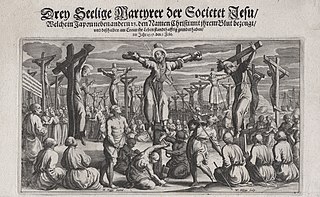The Martyrdom or Crucifixion of Saint Andrew refers to the death of Andrew the Apostle.
It may also refer to:

A martyr is someone who suffers persecution and death for advocating, renouncing, or refusing to renounce or advocate, a religious belief or other cause as demanded by an external party. In colloquial usage, the term can also refer to any person who suffers a significant consequence in protest or support of a cause.
A stake is a large wooden or metal implement designed to be driven into the ground and may refer to:
Saint-Simon or Saint Simon can refer to:
Saint Martin may refer to:

The Acts of Peter is one of the earliest of the apocryphal Acts of the Apostles in Christianity, dating to the late 2nd century AD. The majority of the text has survived only in the Latin translation of the Codex Vercellensis, under the title Actus Petri cum Simone. It is notable for a description of a miracle contest between Saint Peter and Simon Magus, the first record of the tradition that Saint Peter was crucified head-down, and as the origin of the saying Quo vadis?
Dimas can refer to:

The Crucifixion of Saint Andrew (1607) is a painting by the Italian Baroque master Caravaggio. It is in the collection of the Cleveland Museum of Art, which acquired it from the Arnaiz collection in Madrid in 1976, having been taken to Spain by the Spanish Viceroy of Naples in 1610.

Bernardo Daddi was an early Italian Renaissance painter and the leading painter of Florence of his generation. He was one of the artists who contributed to the revolutionary art of the Renaissance, which broke away from the conventions of the preceding generation of Gothic artists, by creating compositions which aimed to achieve a more realistic representation of reality. He was particularly successful with his small-scale works and contributed to the development of the portable altarpiece, a format that subsequently gained great popularity.
Crucifixion is an ancient method of execution.

The Martyrs of Japan were Christian missionaries and followers who were persecuted and executed, mostly during the Tokugawa shogunate period in the 17th century. The Japanese saw the rituals of the Christians causing people to pray, close their eyes with the sign of the cross and lock their hands together – this was seen as psychological warfare against the Japanese and this was punished as such. More than 400 martyrs of Japan have been recognized with beatification by the Catholic Church, and 42 have been canonized as saints.

The Crucifixion is a life sized painting by the Venetian artist Titian, completed in 1558 and presently hanging in the sanctuary of the church of San Domenico, Ancona. Jesus Christ is shown crucified, with Saint Mary and Saint John standing either side of the cross in the Stabat Mater tradition. The kneeling figure is of Saint Dominic. The canvas was completed during Titian's fifth decade of painting, and is one of the works marking a shift toward his extensive exploration of tragedy and human suffering.
Saint Gordianus may refer to:
The Crucifixion of Saint Peter refers to the death of Saint Peter.
The Martyrdom of St Sebastian may refer to:

The Pisa Altarpiece was a large multi-paneled altarpiece produced by Masaccio for the chapel of Saint Julian in the church of Santa Maria del Carmine in Pisa. The chapel was owned by the notary Giuliano di Colino, who commissioned the work on February 19, 1426 for the sum of 80 florins. Payment for the work was recorded on December 26 of that year. The altarpiece was dismantled and dispersed to various collections and museums in the 18th century, but an attempted reconstruction was made possible due to a detailed description of the work by Vasari in 1568.
Martyrdom of Paul may refer to:

The Martyrdom of Saint Andrew is a 1628 painting by Jusepe de Ribera. It depicts the martyrdom of Saint Andrew, one of the Twelve Apostles.
The Martyrdom of St Erasmus can refer to:

Crucifixion of Saint Andrew is a tempera painting by Greek painter Michael Damaskinos. Damaskinos painted in Heraklion, Venice, Sicily, and other parts of Italy. He was associated with the Greek church San Giorgio dei Greci in Venice. His painting of the Crucifixion of Saint Andrew follows the traditional Greek mannerisms prevalent at the time. It is a rare painting of Andrew the Apostle crucified in the same style as his brother Saint Peter. Saint Peter refused to be crucified the same way as Jesus. He was crucified upside down. Saint Andrew is typically crucified in the form of an X rather than the cross. He was crucified in Patras where his remains can be found today at the Cathedral of Saint Andrew, Patras. The Damaskinos painting of the Crucifixion of Saint Andrew can be found at the Byzantine and Christian Museum in Athens, Greece.
The Martyrdom of Saint Catherine may refer to one of a number of paintings: